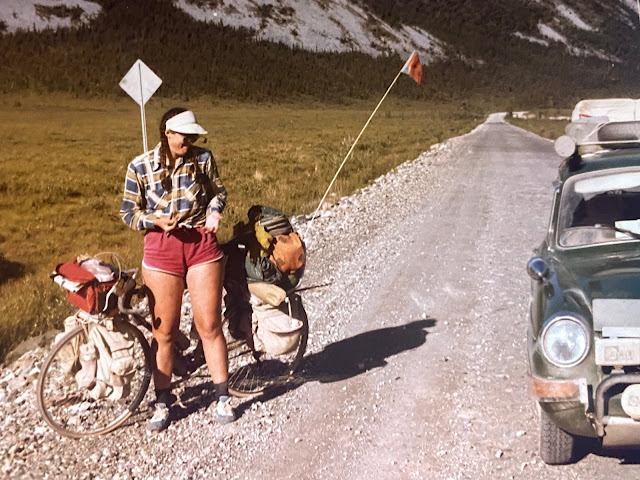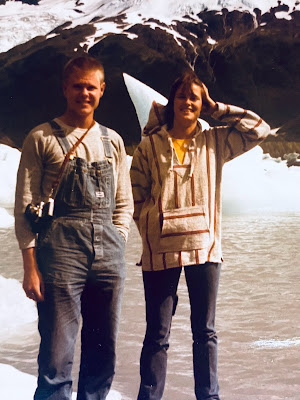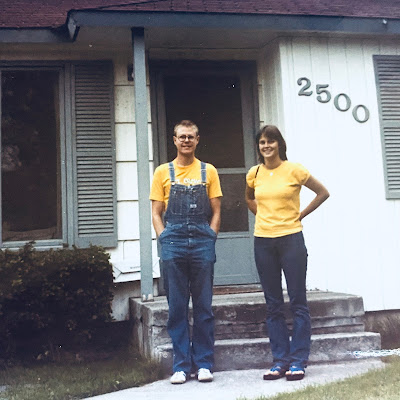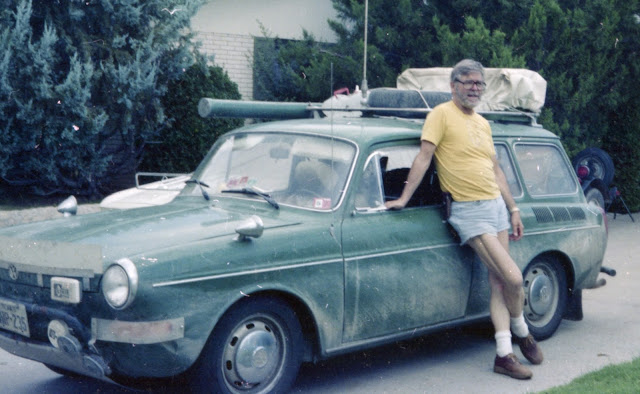Ken and I drove to Alaska. He was retired and I had earned nearly a month of vacation from the library. It was our first trip together as adults and I had a hidden agenda: to come out at the right moment. I brought along Dostoyevsky's Crime and Punishment as Plan B.
 |
| Dinosaur, CO |
 |
| Flaming Gorge, UT |
Ken outfitted his Type III Volkswagen station wagon for the long drive on the Alaska Highway, also known as the "ALCAN" because much it crosses Canada. He was eager to document the trip photographically because he thought VW could use our journey for promotional purposes. I inherited his wishful thinking gene minus the automotive obsession.
Ken never had been camping before. When making his way to see me in New York or going to the Daytona 500, he slept in the car and washed up in the morning at a truck stop or McDonald's. For once, I was the expert. Even four decades ago, it wasn't always easy to find a campsite, and we didn't always have the time (or light) to pitch my tent, the one I bought before going to Maine six years earlier. I can still hear Ken saying "We're roughing it tonight!"
In terms of "amber waves of grain" Canada had the US beat in Alberta. Enormous grain silos along railroad tracks were as numerous as farmhouses.
The ALCAN officially begins in Dawson Creek, British Columbia. Built when Alaska was still an American territory, it connected the 50th state to the mainland United States.
More trucks than passenger vehicles barreled down the 1,700 mile road, most of which was unpaved in 1980.
I thought these might be wild horses until closer inspection revealed that they had been shoed.
 |
| "Four Tails, Five Asses and 16 Legs" |
The tent protected us from rain but not moisture condensation which dripped down on our faces if we had to close the flaps.
Clouds obscured our first view of the Canadian Rockies.
 |
| Muncho Lake, British Columbia |
Mountain goats used the ALCAN, too.
Both Ken and I wished we could add El Paso and New York City to Watson Lake's Signpost Forest, first planted by a homesick construction worker.
Imagine how many signs there must be today!
The Royal Canadian Mounted Police brought back not-so-distant childhood memories of Dudley Do-Right ("Rocky and Bullwinkle" and Mad magazine were primarily responsible for developing my sense of humor). My journal doesn't record any encounters with Mounties, but we did get into a tense altercation with a Canadian customs agent who insisted we must be bringing guns across the border and thoroughly searched the car!
It's probably Tatchun Lake that makes me remember Yukon (then known as the Yukon Territory) with more fondness than any other place on our trip. We had made camp in the rain but the fog had lifted completely by 9:30 a.m.
Ken insisted I take his bare-ass picture before he went down to the lake. "My peter shrunk up so bad I can't even wash it!" he yelled from the chilly waters. TMI.
I climbed a hill to get this shot of the perfect campsite.
These survival huts probably get more use in the winter.
Compared to this bicyclist, Ken and I might as well have been glamping. She and her friend, another student at the University of Montana, had left Missoula, Montana (2,000 miles south) eight weeks earlier with the goal of dipping their toes in the Arctic Ocean. Before departing, they had dried food in bulk and shipped it ahead. "I never even owned a bike before and we've been averaging 50 miles a day," she reported. Their provisions and camping gear weighed close to 100 pounds.
The fish weren't biting with the cheap rods and reels we purchased at Woolworth's. Maybe they were all asleep by 10 p.m. when this shot was taken.
A ground squirrel couldn't get enough of my Saltines stash. Crack for critters.
These photos illustrate the differences between the ways father and son stage their Kodak moments. Dad celebrated "sitting on top of the world" with an empty can of Coors
. . . and I took off my shirt while blasting Lene Lovich. "I'm going to write her a fan letter to let her know that her music has reached the Arctic Circle." Temperature: 64 degrees. Weight: 135 pounds. Need I add that Ken greatly preferred the Sweeney Todd double cassette? I had taken Dave to see it for his 25th birthday the previous March.
A small boat ferried us across the Yukon River, which was the primary means of transportation during the Klondike Gold Rush at the tail end of the 19th century.
Once in Alaska, we saw more modern evidence of gold extraction, including an abandoned mine.
Ken's retired Army status got us a room--and a hot shower--at the BOQ (Bachelor Officers Quarters) in Fairbanks, 4,000 miles from 47 Pianos. There wasn't much to see in town so we re-stocked our provisions at the post exchange and commissary.
Military prices were a lot cheaper than those in the boondocks.
Next stop: Denali National Park and Preserve, home to the indigenously named "high one," then called Mount McKinley, which at more than 20,000 feet is North America's tallest peak.
A guided tour must have been our only sightseeing option; otherwise I can't imagine Ken or I boarding a National Park Service bus near the entrance. Cloud cover obscured a glimpse of the summit. "Denali creates its own weather," said the ranger. 650 people had made the ascent in 1980 by the time we arrived on August 9.
This is as close as we got to any bears. It's difficult to tell that they were blond, a detail that sticks out in my memory as vividly as picking raspberries late in the evening alongside grazing moose in Yukon.
Speaking of moose, moms don't have antlers.
Once we arrived in Anchorage, Ken was hellbent on looking up Colleen, whose parents were friends of his and Lois's. She had followed a man to Alaska and now was tending bar. We spent much of an afternoon tracking her down. Colleen took us to the Birdhouse Bar, deformed by an earthquake and decorated inside with business cards left behind by tourists from all over the world. It eventually burned down.
We also toured the Portage Glacier on the Kenai Peninsula with her.
Colleen, who reminded me of JoAnn, let us crash at her place. She proudly showed us a collection of gold flakes she had received in tips. Single again, she had decided to continue her wanderlust in Maui before the winter darkness and cold descended. Colleen also presented us with "I Drove the Alaska Highway" t-shirts the morning we said goodbye. Ken may have been attempting to play matchmaker. Our body language speaks volumes. For some reason, he couldn't hear it.
 |
| Girl in a Wet Suit Statue |
 |
| Queen Elizabeth Park |
 |
| "Hummingbird" by Claude Davidson (138/300, 1978) |

























































No comments:
Post a Comment